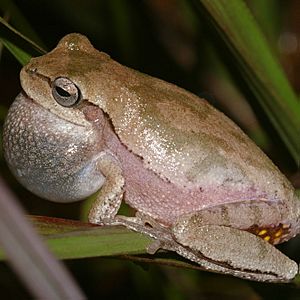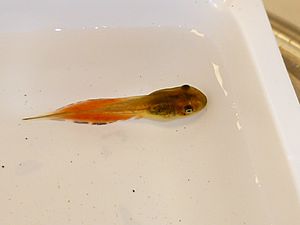Pine woods tree frog facts for kids
Quick facts for kids Pine woods tree frog |
|
|---|---|
 |
|
| Conservation status | |
| Scientific classification | |
| Synonyms | |
|
The pine woods tree frog (Dryophytes femoralis) is a small, amazing frog. It lives only in the southeastern United States. These frogs are part of the Hylidae family, also known as tree frogs.
Contents
About the Pine Woods Tree Frog
Tadpole Life
Pine woods tree frogs lay their eggs in temporary pools of water. These pools might be ditches or puddles that dry up later. The eggs usually hatch into tiny tadpoles in about 24 hours. After 50 to 75 days, these tadpoles change into small froglets. They are about 11 to 15 millimeters long when they become froglets.
Tadpoles can look very different from each other. Just like the squirrel tree frog, the pine woods tree frog tadpole can change its appearance. If dangerous predators, like dragonfly larvae, are around, the tadpole's tail can turn a bright red color! This helps them survive.
Like many amphibian tadpoles, these little frogs can get sick from tiny worms called trematode flatworms. But pine woods tree frog tadpoles have a clever way of swimming. This special swimming style helps keep the worms from infecting their head and body. Instead, the worms mostly go to their tail. Getting infected in the tail causes much less harm to the tadpole.
Adult Features
The pine woods tree frog is a very small frog. It grows to be about 25 to 38 millimeters long. Its color can change a lot. Some are mottled brownish-gray, while others are deep reddish-brown, gray, or even grayish-green. They usually have dark marks on their back.
This frog looks a lot like the squirrel tree frog. But you can tell them apart by looking at the back of their thighs. When you stretch out their back leg, you'll see a line of yellow, orange, or white dots. These dots are a special clue! Their toes have big sticky pads, but not much webbing between them.
You can hear their unique call from April to October. It sounds like a series of short, sharp notes. This makes people call them the "Morse code frog."
Where They Live
The pine woods tree frog lives in the southeastern United States. You can find them along the Atlantic and Gulf Coasts. Their home stretches from Virginia all the way down to Florida and over to Louisiana.
These frogs often climb high up in trees. But sometimes they come down to the ground. They love to live in pine forests, open savannah areas, and woodlands with a mix of pine and turkey oak trees. They also like cypress swamps. When it's dry or cold, they hide. They might go into or under rotten logs, or find moist cracks in trees to stay safe.
Life Cycle and Habits
Pine woods tree frogs mostly eat insects. They are good at catching them!
Breeding can happen any time between March and October. The male frogs call out, especially when the sun is setting. They call from places near water, like trees, bushes, or inside clumps of plants. The female frog lays about 100 eggs. She places them on or just below the water's surface. This water might be a ditch or a temporary pool. The tadpoles grow quickly. They are ready to change into froglets in about two months.
Their Status
The pine woods tree frog is listed as "Least Concern" on the IUCN Red List of Threatened Species. This means they are not in danger of disappearing. Their population is large and seems to be staying steady. They are common in most of the places where they live.
See also
 In Spanish: Dryophytes femoralis para niños
In Spanish: Dryophytes femoralis para niños



